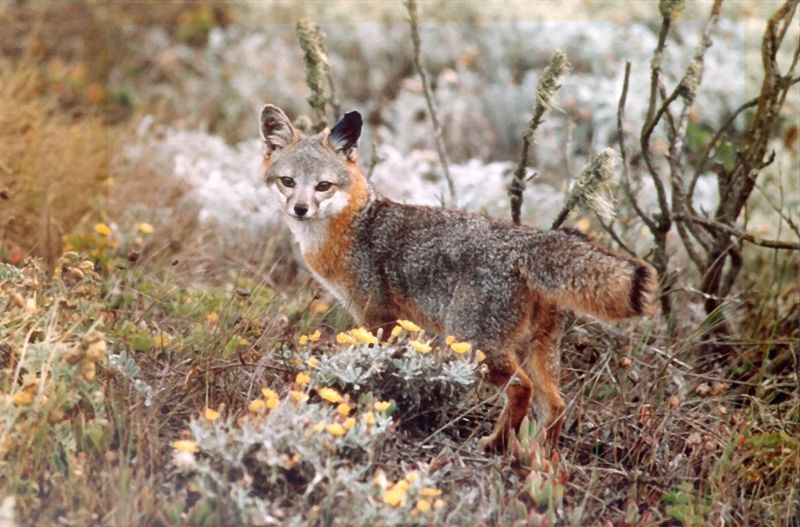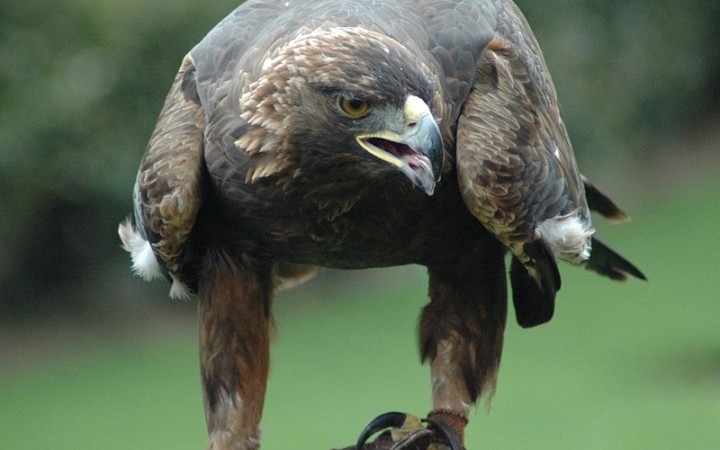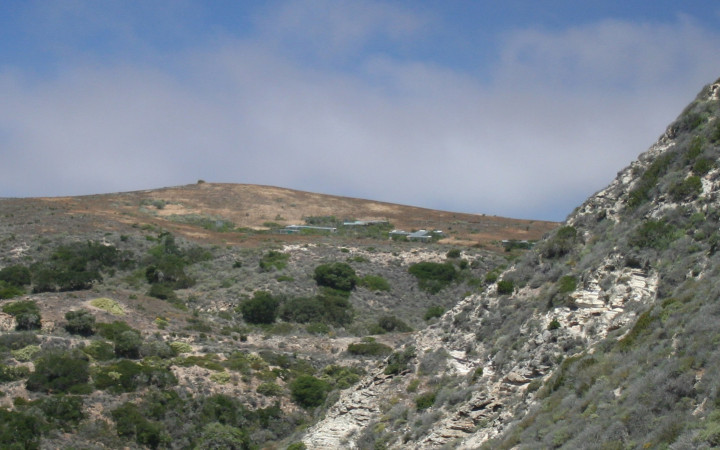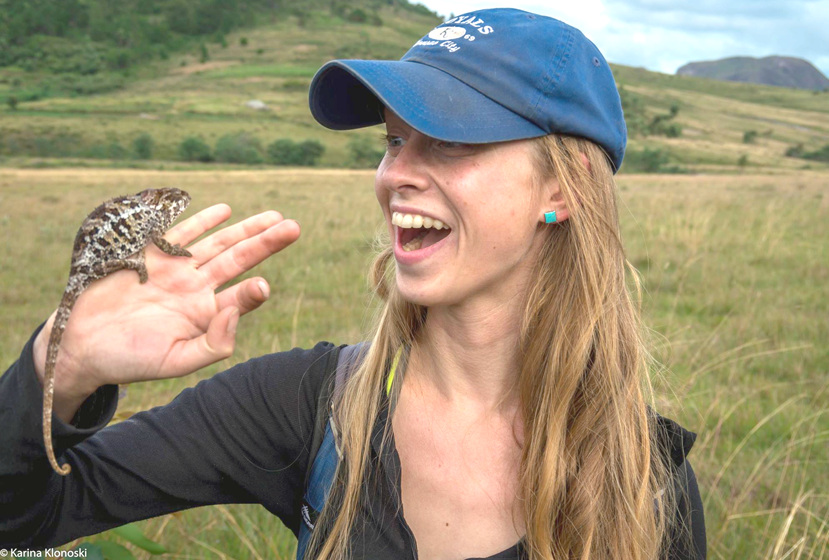
An isolated, wind-battered island in the Pacific. Telltale signs of intruders, venturing far beyond typical stomping grounds, wreaking havoc on locals. And the efforts of detectives, law enforcement, and concerned citizens, helping to crack the mystery and restore balance to a little-known gem of North America.
This isn’t the back-cover synopsis of your favorite Agatha Christie novel. This is the story of the island fox, Urocyon littoralis – a house-cat-sized fox near and dear to visitors of Channel Islands National Park. Though these islands can be seen from the densely populated Southern California shore, few brave the rough ferry ride to visit them. Today, the island fox, a descendant of the gray fox found only in this volcanic archipelago, thrives as the apex predator of each of the islands, unchallenged by any larger carnivore. Fifteen years ago, however, the story of these miniature foxes approached the final chapter no species ever wants to see written: extinction.
[caption id="attachment\\_11833" align="alignleft" width="294"][](http://commons.wikimedia.org/wiki/File:Urocyon\_littoralis\_standing.jpg) The Channel Island fox, Urocyon litoralis. (Wikimedia Commons)[/caption]
When Tim Coonan joined a handful of other biologists to begin monitoring the Channel Islands for the National Park Service (NPS) in 1992, optimism was in the air. After four centuries of intensive ranching and game hunting, the islands were handed over to federal conservation agencies, and the slow but steady recovery of native plants and animals could finally begin. Though hordes of feral sheep, pigs, deer, and elk remained, the fox population held steady: there were no threats to the island fox this far from mainland.
A history of turnover
The Channel Islands had always been the site of continual change. Ten thousand years ago, pygmy mammoths, whose larger ancestors likely swam to the islands across a much lower Pacific Ocean during the most recent Ice Age, went extinct. Around the same time, one of the earliest groups of seafaring humans, the Chumash tribe of Native Americans, began founding dozens of villages across three of the northern Channel Islands: Santa Cruz, Santa Rosa, and San Miguel. The Chumash managed to thrive on the limited natural resources available to them, and also seemed to enjoy a friendly relationship with island foxes, choosing to bury the foxes alongside their own.
[caption id="attachment\\_11834" align="alignright" width="300"][](http://berkeleysciencereview.com/wp-content/uploads/2014/08/IMG\_9100b.jpg) An abandoned tractor on Santa Rosa Island, indicative of 20th-century human exploitation of the Channel Islands. Santa Cruz Island can be seen in the distance on the left. (Levi Gadye)[/caption]
Beginning in the 16th century, human interest in the islands stirred once more. By 1840, Spanish missionaries, Aleutian fur traders, and American and Russian sailors had nearly decimated the Chumash communities, and the remaining Chumash were forcibly relocated to mainland. Following California’s inauguration as the 31st state of the union in 1850, the islands were leased to private individuals, who introduced farm and game animals that soon numbered in the hundreds of thousands. By the time the NPS began the long process of acquiring the islands from those private owners in the 1970s, the lush flora of millennia past had been mostly replaced by sand and weedy grasses. For once, though, there was relative quiet, other than the Pacific wind and waves. The task at hand for the NPS – repairing these damaged ecosystems – would take more than just protecting the islands from humans.
Fox as canary
To aid in their restoration of the islands, NPS biologists chose the island fox as one of several species for ecological monitoring. “It was easy to pick island foxes, because they’re so unique, and so naturally vulnerable due to their low population sizes,” Coonan says. The foxes were tracked with digital tags, allowing the NPS to estimate their wild numbers. As far as wild animals go, the foxes were easy to handle, and easy to tag. The health of the fox population could, in theory, be used to extrapolate the health of the islands as a whole.
As the 1990s progressed, pockets of native vegetation expanded, recolonizing former grazing lands that had been reduced to fields of weeds. However, in 1995, researchers noticed that the fox populations of each island were plummeting. In 1998, the NPS scrambled to place ‘mortality collars’ on select foxes on San Miguel Island to determine the cause of the decline before it was too late. These collars would guide the scientists to any fox that remained stationary for more than six hours, a nearly surefire sign that the fox was either wounded or dead.
[caption id="attachment\\_11835" align="alignleft" width="300"][](http://en.wikipedia.org/wiki/File:GoldenEagle-Nova.jpg) A golden eagle, four times the size of the island fox. Wikimedia Commons (J. Glover).[/caption]
The mortality collars soon alerted the scientists to a half-dozen recently deceased foxes, prompting a wildlife forensics investigation. Surprisingly, five of the fox carcasses bore signs of raptor predation, such as talon marks, and one carcass bore the feather of a large eagle: the golden eagle. The identity of the raptor culprit was confirmed with genetic testing on the recovered feather. “Golden eagles had never been known to nest on the islands,” says Coonan, though “occasionally one would fly out there.” Golden eagles had first been spotted in 1995 on San Miguel Island, but it was assumed that they were not breeding on the islands. What was luring these mainland predators all the way out to the blustery Channel Islands – and keeping them there?
Regardless of that mystery, the island fox decline needed immediate attention. By 1999, a mere 15 foxes remained on each of San Miguel and Santa Rosa Islands, and only 65 remained on Santa Cruz. Knowing that the slightest threat could now wipe out these dwindling fox colonies, the researchers set up pens on each island to house them, as the costly trip to California could expose the foxes to mainland diseases. Meanwhile, the multifaceted cause of the fox decline became more clear.
Connecting the dots
In addition to their historical abuse of the islands via ranching and hunting, humans had also damaged the ecosystem with production of the pesticide DDT. Between the late 1950s and early 1970s, the Montrose Chemical Company dumped 1,700 tons of DDT off the shores of Southern California, contaminating most forms of marine life. The bald eagle, a fish- and bird-eating raptor that had long ruled the Channel Islands uninterested in terrestrial, mammalian prey, like the fox, suffered greatly from the egg-thinning effects of DDT. Bald eagles soon vanished from the islands.
Meanwhile, untended feral pigs flourished into the tens of thousands. Golden eagles, which were known to avoid territory claimed by more dominant bald eagles, pounced on the opportunity to immigrate to a land of plenty that now lacked a “king of the skies”. As Joel Justin, an NPS volunteer, explains, “pig litters can contain up to a dozen little piglets, the perfect meal for a hungry golden eagle.” Thanks to the absence of the bald eagle, the golden eagle was free to set up shop.
Unfortunately, the island foxes had inadvertently become prey for golden eagles. Releasing the foxes would lead to their demise. A team of wildlife experts embarked on an innovative approach to save the island fox. “We reached out to many biologists at the start, and the recovery effort offered opportunities for study in all aspects of fox biology,” says Coonan. Soon, the original handful of NPS employees would be joined by hundreds of volunteers. Additional equipment for housing and caring for the foxes on their home islands was shipped in via helicopter and ferry.
[caption id="attachment\\_11832" align="alignright" width="300"][](http://berkeleysciencereview.com/wp-content/uploads/2014/08/pens.jpg) Low-lying pens left over from the island fox captive breeding program of the mid-2000s, Santa Rosa Island. (Levi Gadye)[/caption]
An experiment in conservation
Zoo experts first helped initiate a captive breeding program, a risky but necessary venture. Field data on breeding patterns, as well as genetic data on unpaired foxes, allowed the researchers to set up unrelated breeding pairs in pens modeled on fox enclosures at zoos. Foxes from each island remained on their home island for captive breeding, and were not mixed, as each island is home to a distinct island fox subspecies. But the threat of the golden eagles remained.
One obvious next step entailed the removal of the non-native pigs that provided the brunt of the golden eagle diet. Though some pig populations had been eliminated in the early 1990s from Santa Rosa Island, biologists wisely surmised that removing the feral pigs across all the islands would actually further endanger island foxes, because the golden eagles would be forced to hunt foxes nearly exlusively. Any manipulation of island wildlife needed to comprise the removal of golden eagles alongside the removal of their primary food source.
To deal with the golden eagles, the Nature Conservancy live-captured 44 golden eagles – four times the number Coonan had expected – between 1999 and 2006, and relocated them to the northeast corner of California. All were tracked, and none have since ventured back. In 2004, to remove the pigs that sustained the golden eagles, the NPS contracted a group from New Zealand, skilled in the removal of invasive wildlife. The job took the New Zealanders just two years, using dogs, rifles, and helicopters to quickly eradicate the pigs across vast terrain.
Lastly, to keep golden eagles away, bald eagles were slowly reintroduced to the islands. A settlement from a lawsuit against the Montrose Company helped pay for Alaskan eaglets, and captive eaglets from the San Francisco Zoo, to be carefully released back into their native island habitat. Today, there are multiple bald eagle nests across the islands, and over 30 individual bald eagles.
Mission accomplished
And what of the island fox? The captive breeding program went so smoothly that some of the foxes were released as early as 2004. The foxes “paired up immediately, spread themselves out over the island, and started doing what they were supposed to do,” says Coonan. The foxes did so well in the wild that they were all released by 2008. Though a renegade golden eagle sometimes flies out to snatch a fox or two from a given Channel Island, the thriving bald eagle population ensures that golden eagles will not begin nesting on the islands again anytime soon.
The multi-pronged approach to save the island fox has yet to be replicated with another endangered species in a similar island environment. Biologists are now documenting the fox carrying capacity of each island, a testament to the research value of these foxes. One hundred foxes per island are vaccinated annually for a particular canid virus as well as for rabies, an unheard-of venture for the NPS for any species. Researchers at UCLA have genetically characterized the ancestry of the fox (it likely diverged from the gray fox 16,000 years ago), while others have investigated island fox heterogeneity (or lack thereof) resulting from the population bottlenecks of island living. Perhaps future research will reveal more about how the island fox’s ancestors adapted to island life through island dwarfism – a phenomenon that also led to the evolution of the now-extinct pygmy mammoth.
The native Chumash likely revered the diminutive, wise island fox, and while little of the Chumash remain, the islands continue to recover, and the fox continues to thrive. We may struggle with future attempts to restore natural habitats, especially when dealing with less-cooperative species than the Channel Island fox, but its story is one we will never forget.
So treat yourself. Spend a day, or better yet a weekend, on the windy beaches and cliffs of the Channel Islands. If you don’t catch an island fox snooping around your campsite during the day, you certainly will see them (or their eyes) at night. With little left to fear on their islands, they might be some of the friendliest foxes left in the world.
[caption id="attachment\\_11837" align="aligncenter" width="300"][](http://berkeleysciencereview.com/wp-content/uploads/2014/08/IMG\_9230b.jpg) Exploring the coastal cliffs of Santa Rosa Island. (Levi Gadye)[/caption



